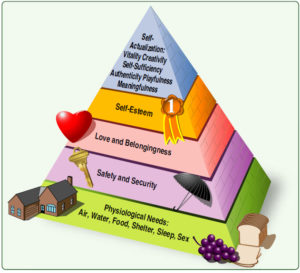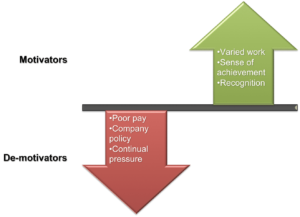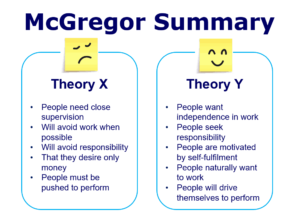Motivation
Motivation is the word derived from the word ‘motive’ which means needs, desires, wants or drives within the individuals. It is the process of stimulating people to actions to accomplish the goals. In the work goal context the psychological factors stimulating the people’s behaviour can be –
- desire for money
- success
- recognition
- job-satisfaction
- team work, etc
Motivation can be described as the internal force that impacts the direction, intensity, and endurance of a person’s voluntary choice of behavior. It consists of −
Direction − focused by goals.
Intensity − bulk of effort allocated.
Persistence − amount of time taken for the effort to be exerted.
Features of Motivation
Motivation is an internal feeling, that is, it defines the psychological state of a person. It is a continuous process and we should make sure that it is not disturbed. A person should be encouraged completely.
Motivation consists of three interacting and dependent elements −
- Needs − The requirements or deficiency which is created whenever there is physiological imbalance.
- Drives − The various camps or events organized to motivate the employees and give them new opportunities.
- Incentives − Employees need to be rewarded for their nice work in order to keep them encouraged.
Classical Theories of Motivation
The motivation concepts were mainly developed around 1950’s. Three main theories were made during this period. These three classical theories are-
Maslow’s Hierarchy of Needs Theory
This theory was produced in order to answer the question “What motivates an individual”. Every second need comes to force when the first need is satisfied completely. Maslow explained the hierarchy of needs by grouping them into two: deficiency needs and growth needs.

Physiological Needs
Every individual needs to take care of the basic requirements required to sustain. These requirements include food to eat, clothing to wear and shelter to live in. These necessities are relatively independent of each other but are finite.
Safety Needs
Everybody wants to stay in a protected environment with minimal danger so that they can have a peaceful life. Safety needs basically includes protection from physiological danger like accident and having economic security like bank accounts, health insurance
In an enterprise, it includes job security, salary increment, etc. The managerial practice to satisfy this involves offering pension scheme, provident fund, gratuity etc.
Social Needs
We have all heard that man is a social animal, we want to be there with those people where we are loved and we are accepted as we are; nobody wants to be judged. This is a common requirement every human desires.
This theory helps managers to think about encouraging their employees by identifying employee needs. In short, it presents motivation as constantly changing force, expressing itself to the constant need for fulfilment of new and higher levels of needs.
Esteem
Esteem means the typical human desire to be accepted and valued by others. People often involve in a profession or hobby to gain recognition, earn fame and respect. According to Maslow, the needs of humans have strict guidelines – the hierarchies rather than being sharply separated, are interrelated. This means that esteem and the consequent levels are not strictly separated but are closely related.
Self-Actualization
Self-actualization means realizing one’s full potential. Maslow describes this as a desire to complete everything that one can, to become the most that one can be.
Limitations of Maslow’s Theory
- It is essential to note that not all employees are governed by same set of needs. Different individuals may be driven by different needs at same point of time. It is always the most powerful unsatisfied need that motivates an individual.
- The theory is not empirically supported.
- The theory is not applicable in case of starving artist as even if the artist’s basic needs are not satisfied, he will still strive for recognition and achievement.
Herzberg’s Two-Factor Theory of Motivation
In 1959, Frederick Herzberg, a behavioural scientist proposed a two-factor theory or the motivator-hygiene theory. According to Herzberg, there are some job factors that result in satisfaction while there are other job factors that prevent dissatisfaction. According to Herzberg, the opposite of “Satisfaction” is “No satisfaction” and the opposite of “Dissatisfaction” is “No Dissatisfaction”.

Herzberg classified these job factors into two categories-
- Hygiene factors– Hygiene factors are those job factors which are essential for existence of motivation at workplace. These do not lead to positive satisfaction for long-term. But if these factors are absent / if these factors are non-existant at workplace, then they lead to dissatisfaction. Hygiene factors are also called as dissatisfiers or maintenance factors as they are required to avoid dissatisfaction. The hygiene factors symbolized the physiological needs which the individuals wanted and expected to be fulfilled.
- Motivational factors– According to Herzberg, the hygiene factors cannot be regarded as motivators. The motivational factors yield positive satisfaction. These factors are inherent to work. These factors motivate the employees for a superior performance. These factors are called satisfiers. Motivational factors include:
- Recognition – The employees should be praised and recognized for their accomplishments by the managers.
- Sense of achievement – The employees must have a sense of achievement. This depends on the job. There must be a fruit of some sort in the job.
- Growth and promotional opportunities – There must be growth and advancement opportunities in an organization to motivate the employees to perform well.
- Responsibility – The employees must hold themselves responsible for the work. The managers should give them ownership of the work. They should minimize control but retain accountability.
- Meaningfulness of the work – The work itself should be meaningful, interesting and challenging for the employee to perform and to get motivated.
Limitations of Two-Factor Theory
The two factor theory is not free from limitations:
- The two-factor theory overlooks situational variables.
- Herzberg assumed a correlation between satisfaction and productivity. But the research conducted by Herzberg stressed upon satisfaction and ignored productivity.
- The theory’s reliability is uncertain. Analysis has to be made by the raters. The raters may spoil the findings by analyzing same response in different manner.
- No comprehensive measure of satisfaction was used. An employee may find his job acceptable despite the fact that he may hate/object part of his job.
- The two factor theory is not free from bias as it is based on the natural reaction of employees when they are enquired the sources of satisfaction and dissatisfaction at work. They will blame dissatisfaction on the external factors such as salary structure, company policies and peer relationship. Also, the employees will give credit to themselves for the satisfaction factor at work.
- The theory ignores blue-collar workers. Despite these limitations, Herzberg’s Two-Factor theory is acceptable broadly.
Theory X and Theory Y
In 1960, Douglas McGregor formulated Theory X and Theory Y suggesting two aspects of human behaviour at work, or in other words, two different views of individuals (employees): one of which is negative, called as Theory X and the other is positive, so called as Theory Y. According to McGregor, the perception of managers on the nature of individuals is based on various assumptions.
Assumptions of Theory X
of Theory X
- An average employee intrinsically does not like work and tries to escape it whenever possible.
- Since the employee does not want to work, he must be persuaded, compelled, or warned with punishment so as to achieve organizational goals. A close supervision is required on part of managers. The managers adopt a more dictatorial style.
- Many employees rank job security on top, and they have little or no aspiration/ ambition.
- Employees generally dislike responsibilities.
- Employees resist change.
- An average employee needs formal direction.
Assumptions of Theory Y
- Employees can perceive their job as relaxing and normal. They exercise their physical and mental efforts in an inherent manner in their jobs.
- Employees may not require only threat, external control and coercion to work, but they can use self-direction and self-control if they are dedicated and sincere to achieve the organizational objectives.
- If the job is rewarding and satisfying, then it will result in employees’ loyalty and commitment to organization.
- An average employee can learn to admit and recognize the responsibility. In fact, he can even learn to obtain responsibility.
- The employees have skills and capabilities. Their logical capabilities should be fully utilized. In other words, the creativity, resourcefulness and innovative potentiality of the employees can be utilized to solve organizational problems.
Thus, we can say that Theory X presents a pessimistic view of employees’ nature and behaviour at work, while Theory Y presents an optimistic view of the employees’ nature and behaviour at work. If correlate it with Maslow’s theory, we can say that Theory X is based on the assumption that the employees emphasize on the physiological needs and the safety needs; while Theory X is based on the assumption that the social needs, esteem needs and the self-actualization needs dominate the employees.
McGregor views Theory Y to be more valid and reasonable than Theory X. Thus, he encouraged cordial team relations, responsible and stimulating jobs, and participation of all in decision-making process.
